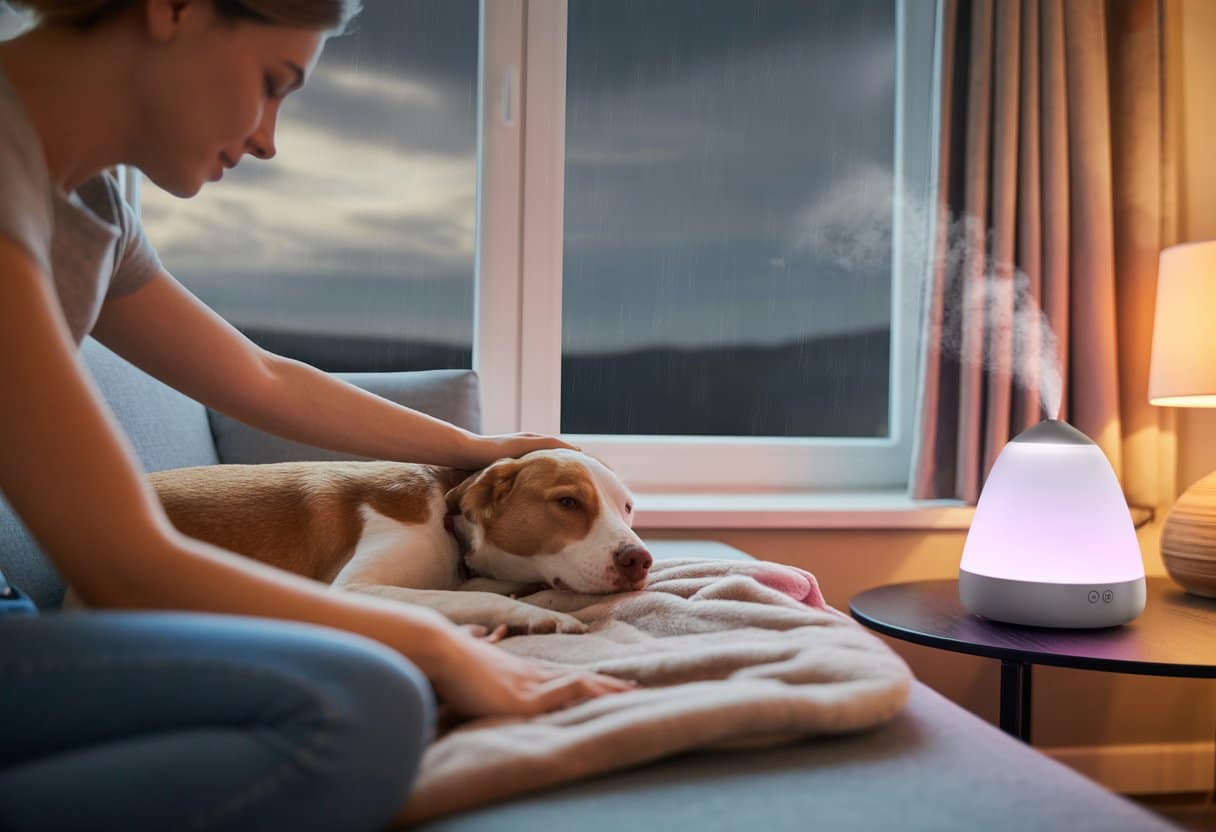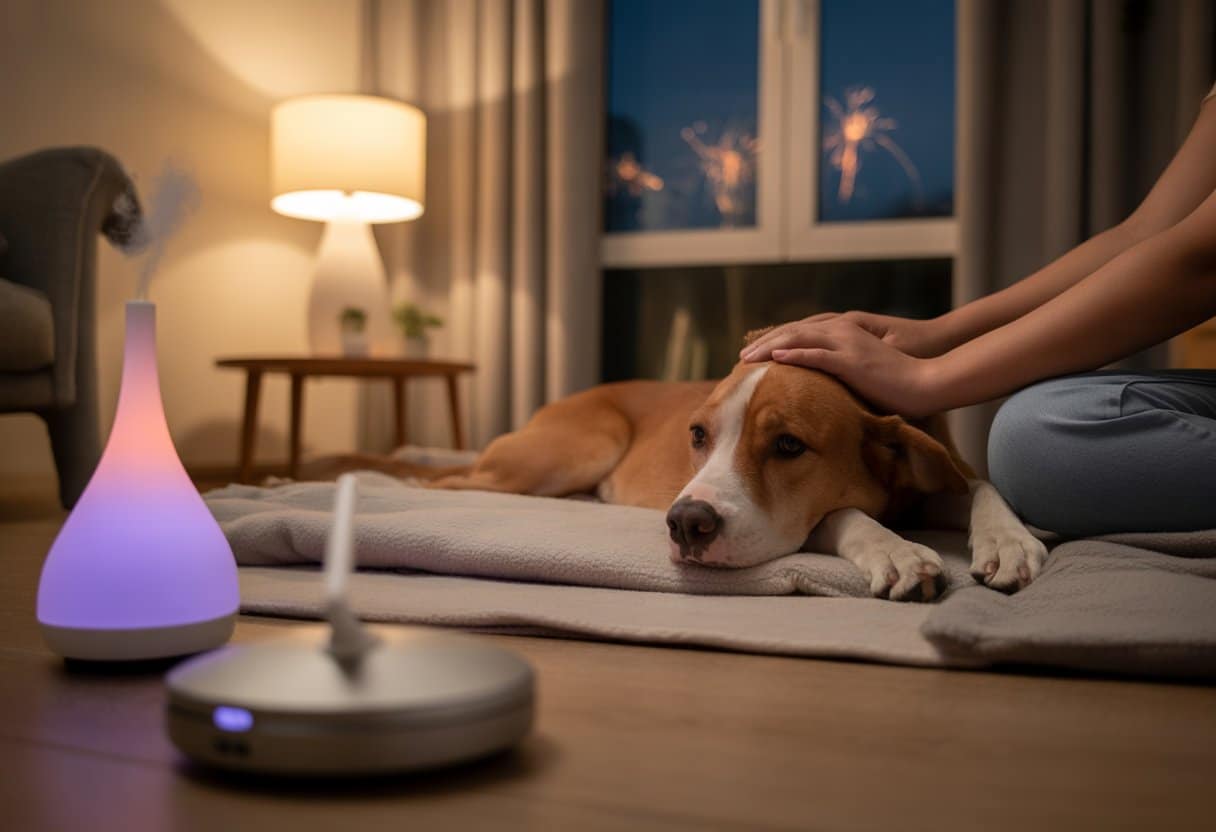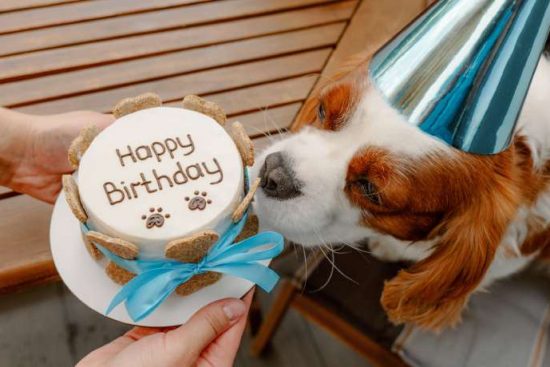
Fireworks and thunderstorms can turn a calm evening into a stressful event for pets. Loud noises, bright flashes, and sudden changes in the environment are common triggers that can lead to anxiety and even panic.
Many simple techniques can help right away, such as using calming vests, playing soothing music, or masking outside noise with white noise machines. Tools like calming wraps and anxiety vests or pet-safe sound therapies are proven to help soothe pets.
Over time, regular training and special products or supplements may also make a difference.
Key Takeaways
- Recognize signs of anxiety in pets during storms and fireworks.
- Use proven calming techniques and safe spaces for quick relief.
- Long-term results come from consistent training and supportive products.
Understanding Noise Anxiety in Pets
Noise anxiety in pets often causes distress during events like fireworks displays and thunderstorms. Loud, unpredictable sounds can create real discomfort for dogs and cats, especially at times like the Fourth of July or summer holidays.
Common Causes of Anxiety
Loud noises such as fireworks, thunderstorms, and emergency sirens are leading triggers of anxiety in pets. Fireworks are sudden, intense, and can make the floors and walls shake, which animals may find frightening.
Thunderstorms create booming sounds and flashes of lightning that pets can’t understand. Dogs and cats have more sensitive hearing than humans.
This means they notice noises from further away and with more intensity. Even distant fireworks can be disturbing.
Changes in their environment, like new people or being left alone during holidays, can also add to their stress. Loud celebrations, such as fireworks displays, often lead to higher cases of noise phobia in pets.
Signs of Noise Anxiety
There are clear signals that a pet is experiencing noise anxiety. Some common signs include:
- Shaking or trembling
- Hiding in small spaces
- Excessive barking or meowing
- Panting and drooling
- Trying to escape rooms or yards
Some pets may pace, cling to their owners, or refuse to eat. Cats may also run under furniture.
These signs often appear suddenly during fireworks or thunderstorms. Heightened behaviors usually mean the pet is feeling severe fear and anxiety.
Understanding these signs helps pet owners respond quickly and give comfort.
How Anxiety Impacts Pet Health
Long-term anxiety can harm a pet’s overall wellbeing. Frequent exposure to loud events, such as the Fourth of July, can lead to ongoing fear and stress.
Persistent anxiety may disrupt sleep, lower immunity, and cause digestive issues. Behavioral problems can develop, including destructive actions or accidents in the house.
Some pets may become withdrawn or aggressive due to their discomfort. Chronic anxiety can reduce a pet’s quality of life, making them less playful and energetic.
According to experts, ongoing exposure to noise phobia triggers can make anxiety in pets worse over time.
Immediate Calming Strategies for Fireworks and Thunderstorms
Dogs and cats often feel anxious during loud storms or fireworks. Quick actions can help reduce stress and support calm behavior.
Creating a Safe Space
Creating a safe space for pets is one of the most helpful ways to ease anxiety. Choose a room far from windows where outside noise is softer.
Many pets feel more secure in a small area, such as a bathroom, closet, or under a sturdy table. Add familiar bedding and favorite toys to make it cozy.
Dimming the lights can also help keep things calm. Some owners use crates, but the door should stay open so the animal does not feel trapped.
Pets also respond well to routine, so try to stay with them and act normal, speaking in a relaxed tone. These comfort cues signal it is safe.
If your pet already hides when scared, place water, treats, and cushions in that spot before the event. This lets them retreat without feeling isolated.
Using White Noise and Calming Music
Sounds like white noise or calming music can mask sudden booms and rumbles. Devices such as fans, air purifiers, or special sound machines create a steady background that makes outside noise less startling.
Many pet owners use music designed for animals. For example, there are playlists made to reduce stress in dogs and cats, playing gentle, slow tunes.
Try turning on calming arrangements before the noise begins to help a pet settle faster. Classical music or soft jazz are often good choices.
Some people use TV or radio if special music is not available. Regularly playing these sounds can help pets become more used to them, so when storms or fireworks happen, they do not react as strongly.
The goal is to keep sudden noises from standing out and triggering anxiety. Learn more about using white noise and music at this guide to reducing pet anxiety.
Comfort Items and Anxiety Vests
Comfort items like a soft blanket or a cherished toy give pets something familiar during stressful times. Some animals like to cuddle up with their owner’s clothing, as the scent can be very calming.
Anxiety vests such as a Thundershirt provide gentle, constant pressure to the body. This pressure can help some pets feel calmer, much like a hug.
Thundershirts and similar vests are safe for most pets if worn as directed. It is best to try these before fireworks or storms so the pet can get used to the feeling.
The effect is not instant for every animal, but when used with safe spaces and calming sounds, both comfort items and vests can be helpful. For more about calming products, check out these tips to calm your dog during fireworks.
Behavioral Modification and Training Techniques
Some dogs develop a noise phobia when exposed to fireworks or thunderstorms. Effective behavioral modification and training can help them feel safer and build better responses during these stressful times.
Desensitization Training Methods
Desensitization training exposes a dog to recorded sounds of fireworks or thunderstorms at a very low volume. The owner then slowly increases the sound over many days and sessions.
The goal is to help the dog get used to loud noises without becoming scared. To use this method, a calm and quiet space works best.
Short sessions, five to ten minutes each, are recommended at first. If the dog stays relaxed, the volume can go up a little.
If the dog shows signs of fear, turn the volume back down or stop for that day. Gradual exposure helps reduce sensitivity to noise over time.
This technique should always move at the dog’s pace. Tools like calming treats or favorite toys can help the dog feel more comfortable during practice.
For those seeking more guidance, desensitization training for noise phobia is recommended by many professionals.
Positive Reinforcement Practices
Positive reinforcement rewards calm behavior with treats, gentle praise, or play. This approach makes it more likely for a dog to stay relaxed the next time it hears loud sounds.
Owners can give a treat every time the dog sits quietly during thunder or fireworks. Rewards should happen right after the calm behavior, so the dog makes a clear connection.
For best results, use high-value treats or a favorite toy. Avoid scolding or punishment, as these can increase stress or fear.
Even simple changes, like asking the dog to perform basic commands or giving a chew toy during stressful events, can help. Success comes from matching rewards to the dog’s preferences and practicing regularly.
Many experts recommend positive reinforcement training as a core part of managing noise anxiety.
Natural and Supplemental Anxiety Relief Options

Many pets can find relief from anxiety during fireworks or thunderstorms with natural or supplemental products. These include pheromone-based solutions, herbal remedies, essential oils, and calming treats designed for pets.
Pheromone-Based Products
Pheromone-based anxiety relief uses synthetic versions of the natural calming scents that pets produce. These scents can help pets feel safe and relaxed when they are stressed.
Feliway is a popular pheromone product for cats. It comes in diffusers, sprays, or wipes and can be used in areas where the cat spends time.
For dogs, pheromone diffusers and collars often use dog-appeasing pheromones, which mimic the scent of a mother dog to calm adult dogs. Pheromone products are generally easy to use and have little to no scent for humans.
They are safe for most pets, but results can vary. Some owners see a clear change in behavior, while others notice only a small difference.
Consistency is key—these products work best when used regularly, especially during stressful times like fireworks.
Herbal Remedies and Essential Oils
Herbal remedies can offer gentle support for stressed pets. Valerian root, chamomile, and passionflower are often used in pet-safe forms to help quiet nerves.
Essential oils, such as lavender, also have calming properties, but they must be used very carefully. Certain oils are toxic to pets, and even safe options can be too strong if not diluted properly.
Never apply oils directly to pets without talking to a veterinarian first.
Owners can use safe herbal sprays or diffusers in the pet’s bedding area. Treats made with calming herbs are another option.
Some products mix several herbs for a stronger effect. Always start with low amounts to check for reactions and closely follow usage instructions.
Learn more about natural remedies for dogs and other calming options.
Calming Treats and Supplements
Calming treats and supplements contain ingredients like L-theanine, melatonin, and sometimes CBD oil. These substances help manage stress and support relaxation in pets during loud events.
Treats may also include herbs like valerian or passionflower, making them a good choice for pets that do not like sprays or diffusers. Many owners like treats because they are easy to give and most pets find them tasty.
Some treats help pets feel calmer within 30 to 60 minutes. Supplements may also come as chewables or liquids.
Always read dosing instructions and start low, especially for small pets.
For more information on CBD oil and calming supplements, check recommended dosage and discuss any new product with your veterinarian.
Long-Term Management and Prevention

Consistent routines and early preparation are key to lowering anxiety in pets. Taking steps ahead of stressful events and working closely with professionals improves pets’ coping skills and comfort.
Planning Around Holidays and Events
Many pets become anxious during holidays with fireworks, like the Fourth of July. Knowing when these events will occur helps owners prepare their pets in advance.
Keeping pets indoors during fireworks displays, closing windows, and playing white noise or calming music can help reduce exposure to loud sounds. Creating a safe space, such as a quiet room with their favorite toys, makes pets feel more secure.
Introducing food puzzles or long-lasting treats offers a positive distraction during loud events.
Regular practice with sound desensitization, like slowly exposing pets to low-level fireworks or storm sounds, can help them adapt over time.
Owners should also check their yards and fences before holidays to make sure pets cannot escape if startled.
For more tips on holiday planning and distractions, visit these firework anxiety strategies for dogs and this list of distraction techniques.
Working With Veterinarians and Professionals
Veterinarians play a crucial role in managing long-term anxiety in pets. They can suggest anti-anxiety medications or supplements, which should be tested ahead of time for side effects.
Professional behaviorists might recommend desensitization programs or counterconditioning to slowly reduce fear through controlled exposure.
Regular check-ins with a veterinarian ensure any supplements or medications are working and are safe for long-term use.
A behaviorist can also help create a tailored plan to address ongoing anxiety through training sessions.
If needed, veterinarians can guide pet owners on using calming products or refer them to trainers who use science-based behavior methods.
Owners should always follow professional advice and track improvement to adjust care as needed.
Frequently Asked Questions
There are many simple actions pet owners can take to help their dogs feel safe during fireworks and thunderstorms. It is important to know what signs of anxiety look like and which methods or treatments have been shown to be safe and effective.
What are some effective ways to comfort dogs during fireworks?
Calming dogs during fireworks starts by creating a safe and quiet place for them. Using familiar items like their favorite bed or toys can bring comfort.
Sound therapy with calming music or white noise can help mask loud sounds. Extra playtime before the event can also help release energy and stress.
For more strategies, visit this guide on pet anxiety during fireworks.
Which home remedies are helpful for dogs with fireworks or thunderstorm anxiety?
Some dogs benefit from products like Thundershirts, which gently wrap the body and reduce stress. Calming treats with natural ingredients such as chamomile or valerian root may help.
Introducing gentle background music or a fan can make sudden sounds less noticeable. These simple steps can be started at home with little risk.
What types of medication are available for dogs with thunderstorm anxiety?
There are prescription medications available from veterinarians that treat anxiety in dogs. These may include drugs like trazodone, alprazolam, or fluoxetine.
Medications are usually considered when other methods do not work. The right choice depends on the dog’s health and severity of anxiety, so a veterinarian’s advice is needed.
How can I recognize symptoms of anxiety in my pet caused by fireworks?
Common signs of anxiety include panting, drooling, trembling, hiding, and trying to escape. Some pets may whine, bark, or become destructive during loud events.
Close observation helps owners spot these behaviors early and take quick action to comfort their pet.
What are the safe dosages of Benadryl for a dog with fireworks anxiety?
The usual dose of Benadryl (diphenhydramine) for dogs is about 1 mg per pound of body weight, given two to three times daily. However, it is important to consult a veterinarian before giving any medication.
Some dogs may be allergic or have other health issues that make Benadryl unsafe.
How can I safely calm my dog during a noisy event like fireworks or thunder?
Safe ways to calm a dog include letting them stay indoors in a quiet room. Using soothing music and keeping windows and curtains closed can also help.
Walking your dog earlier in the day can help them avoid the noise and burn off energy, as suggested in this article on keeping dogs calm during fireworks.
Always have pets wear a collar with identification in case they get scared and run away. If anxiety remains severe, talk with a veterinarian about other safe options.




